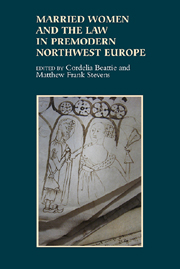Book contents
- Frontmatter
- Contents
- Figures and Tables
- Contributors
- Introduction: Uncovering Married Women
- 1 Inheritance, Property and Marriage in Medieval Norway
- 2 Spousal Disputes, the Marital Property System, and the Law in Later Medieval Sweden
- 3 When Two Worlds Collide: Marriage and the Law in Medieval Ireland
- 4 Married Women, Crime and the Courts in Late Medieval Wales
- 5 Peasant Women, Agency and Status in Mid-Thirteenth- to Late Fourteenth-Century England: Some Reconsiderations
- 6 London's Married Women, Debt Litigation and Coverture in the Court of Common Pleas
- 7 Married Women, Contracts and Coverture in Late Medieval England
- 8 Property, Family and Partnership: Married Women and Legal Capability in Late Medieval Ghent
- 9 ‘For His Interest’? Women, Debt and Coverture in Early Modern Scotland
- 10 The Worth of Married Women in the English Church Courts, c.1550–1730
- 11 Married Women, Work and the Law: Evidence from Early Modern Germany
- Index
3 - When Two Worlds Collide: Marriage and the Law in Medieval Ireland
Published online by Cambridge University Press: 05 July 2013
- Frontmatter
- Contents
- Figures and Tables
- Contributors
- Introduction: Uncovering Married Women
- 1 Inheritance, Property and Marriage in Medieval Norway
- 2 Spousal Disputes, the Marital Property System, and the Law in Later Medieval Sweden
- 3 When Two Worlds Collide: Marriage and the Law in Medieval Ireland
- 4 Married Women, Crime and the Courts in Late Medieval Wales
- 5 Peasant Women, Agency and Status in Mid-Thirteenth- to Late Fourteenth-Century England: Some Reconsiderations
- 6 London's Married Women, Debt Litigation and Coverture in the Court of Common Pleas
- 7 Married Women, Contracts and Coverture in Late Medieval England
- 8 Property, Family and Partnership: Married Women and Legal Capability in Late Medieval Ghent
- 9 ‘For His Interest’? Women, Debt and Coverture in Early Modern Scotland
- 10 The Worth of Married Women in the English Church Courts, c.1550–1730
- 11 Married Women, Work and the Law: Evidence from Early Modern Germany
- Index
Summary
After the Anglo-Norman invasion of 1169 two entirely different legal systems concerning women and their rights upon marriage co-existed within Ireland. One system was based on the principles and tenets of the English common law which the invaders brought with them in the later twelfth century. This legal system enforced coverture, that is, the basic premise that, legally, married women were under the rule of their husbands. In contrast to this, Gaelic Irish society functioned according to its own ancient legal code, commonly called the Brehon law, which had reached its apogee and received codification in the seventh and eighth centuries but which was still in use in the later medieval period. Under this system women's rights after marriage were often very different from those provided for under the imported English common law. Because the two co-existing legal systems and societies were so different, women's experiences after marriage varied greatly within Ireland. These systems flourished and evolved separately but did not integrate or amalgamate in any way successfully. Of course certain habits and practices were adopted by both sides, but not to a significant extent. Indeed there was no overwhelming desire on either side to accommodate the traditions of the other, and thus these two societies grew ever more separate and alien to each other. Problems also occurred when intermarriage took place, as often both the married couple and those around them were confused as to which legal system to follow when it came to the woman's rights at marriage.
- Type
- Chapter
- Information
- Married Women and the Law in Premodern Northwest Europe , pp. 53 - 70Publisher: Boydell & BrewerPrint publication year: 2013



